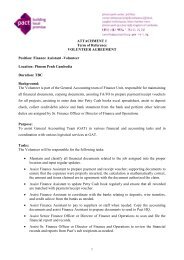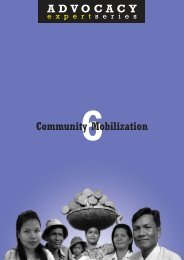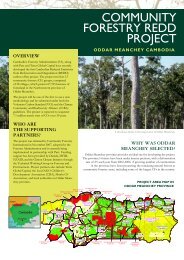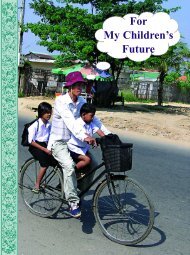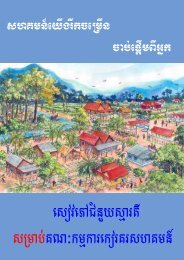Advocacy in Cambodia: Increasing Democratic ... - Pact Cambodia
Advocacy in Cambodia: Increasing Democratic ... - Pact Cambodia
Advocacy in Cambodia: Increasing Democratic ... - Pact Cambodia
You also want an ePaper? Increase the reach of your titles
YUMPU automatically turns print PDFs into web optimized ePapers that Google loves.
Increas<strong>in</strong>g <strong>Democratic</strong> Space<br />
less press<strong>in</strong>g need for NGOs to organize them. On<br />
occasion networks have not sufficiently<br />
coord<strong>in</strong>ated their events, especially International<br />
Women’s Day, result<strong>in</strong>g <strong>in</strong> low turnout at some<br />
<strong>in</strong>dividual events because too many events were<br />
organized on the same day. As special events<br />
consume energy, time, and resources,<br />
coord<strong>in</strong>ation needs to be a priority and<br />
effectiveness carefully analyzed.<br />
Most advocacy campaigns have not featured<br />
a strategic media campaign, though advocat<strong>in</strong>g<br />
organizations are learn<strong>in</strong>g to court the media. The<br />
most common media strategies <strong>in</strong>clude press<br />
releases, radio, and television spots. More<br />
<strong>in</strong>novative approaches <strong>in</strong>clude <strong>in</strong>vit<strong>in</strong>g journalists<br />
on field trips to learn about a situation or video<br />
tap<strong>in</strong>g speeches made by the Prime M<strong>in</strong>ster and<br />
high officials to circulate at the village level that<br />
<strong>in</strong>form villagers of promises made. In view of the<br />
importance of the media <strong>in</strong> rais<strong>in</strong>g awareness and<br />
generat<strong>in</strong>g sympathy for a cause, a separate<br />
section on media strategies is presented below.<br />
Stag<strong>in</strong>g Organized Action<br />
Civil society groups have been conduct<strong>in</strong>g<br />
organized action <strong>in</strong> the form of demonstrations,<br />
strikes, and peace marches s<strong>in</strong>ce before the 1993<br />
elections. Marches are a regular part of special<br />
event days such as International Women’s Day.<br />
Demonstrations <strong>in</strong> front of national <strong>in</strong>stitutions<br />
such as the National Assembly, Royal Palace,<br />
Independence Monument, and Wat Phnom also<br />
feed <strong>in</strong>to media campaigns, as any time large<br />
groups of people gather the media will usually<br />
attend.<br />
Examples of demonstrations <strong>in</strong>clude<br />
the march for the Commune Council<br />
Election Law lobby<strong>in</strong>g and, more recently,<br />
the demonstration organized by Women<br />
For Prosperity to protest the suspicious<br />
deaths of three women commune council<br />
candidates. The demonstrations serve<br />
ma<strong>in</strong>ly as a symbolic protest to express<br />
the anger and solidarity of a group or<br />
network. As demonstrations consume<br />
enormous amounts of energy and<br />
resources, it is important for organizers<br />
to have a clear understand<strong>in</strong>g of the<br />
<strong>in</strong>tended effect of a demonstration, as well<br />
as possible roadblocks to organiz<strong>in</strong>g an<br />
effective one. NGOs have experienced<br />
delays <strong>in</strong> the past <strong>in</strong> obta<strong>in</strong><strong>in</strong>g<br />
authorization from the Phnom Penh<br />
Municipality to organize demonstrations<br />
and occasionally have not received<br />
authorization to march, as was the case<br />
when 20 NGOs wanted to demonstrate<br />
aga<strong>in</strong>st corruption <strong>in</strong> 2001. Some<br />
PADV held this event dur<strong>in</strong>g Women’s Day<br />
2002 to raise awareness about <strong>Cambodia</strong>’s<br />
domestic violence problem. Banteay Meanchey<br />
prov<strong>in</strong>ce.<br />
demonstrations have small attendance. Follow up<br />
to demonstrations is important and organizers<br />
need to learn how the energy generated dur<strong>in</strong>g an<br />
event can be harnessed for future activities.<br />
The ma<strong>in</strong> protest recourse for garment<br />
workers is the strike, which uses controlled<br />
conflict as a barga<strong>in</strong><strong>in</strong>g tool. Strikes can take the<br />
form of marches and demonstrations outside<br />
factories or of work stoppage, <strong>in</strong> which workers<br />
enter factories, punch their time cards, but refuse<br />
to work. Both strategies have become common<br />
practice <strong>in</strong> <strong>Cambodia</strong>, and a review of press articles<br />
from the past two years <strong>in</strong>dicates that <strong>in</strong> most<br />
cases workers are able to w<strong>in</strong> limited concessions<br />
through such action. Pro-enterprise supporters<br />
argue however, that demonstrations are not<br />
effective because workers automatically lose their<br />
regular attendance bonus of $5 paid at the end of<br />
Women For Prosperity (WFP) organized a non-violence march<br />
around Wat Phnom <strong>in</strong><br />
January 2002 to protest<br />
the suspicious deaths of<br />
three women commune<br />
council candidates. The<br />
WFP Director spoke to<br />
participants dur<strong>in</strong>g the<br />
demonstration (left).<br />
26






